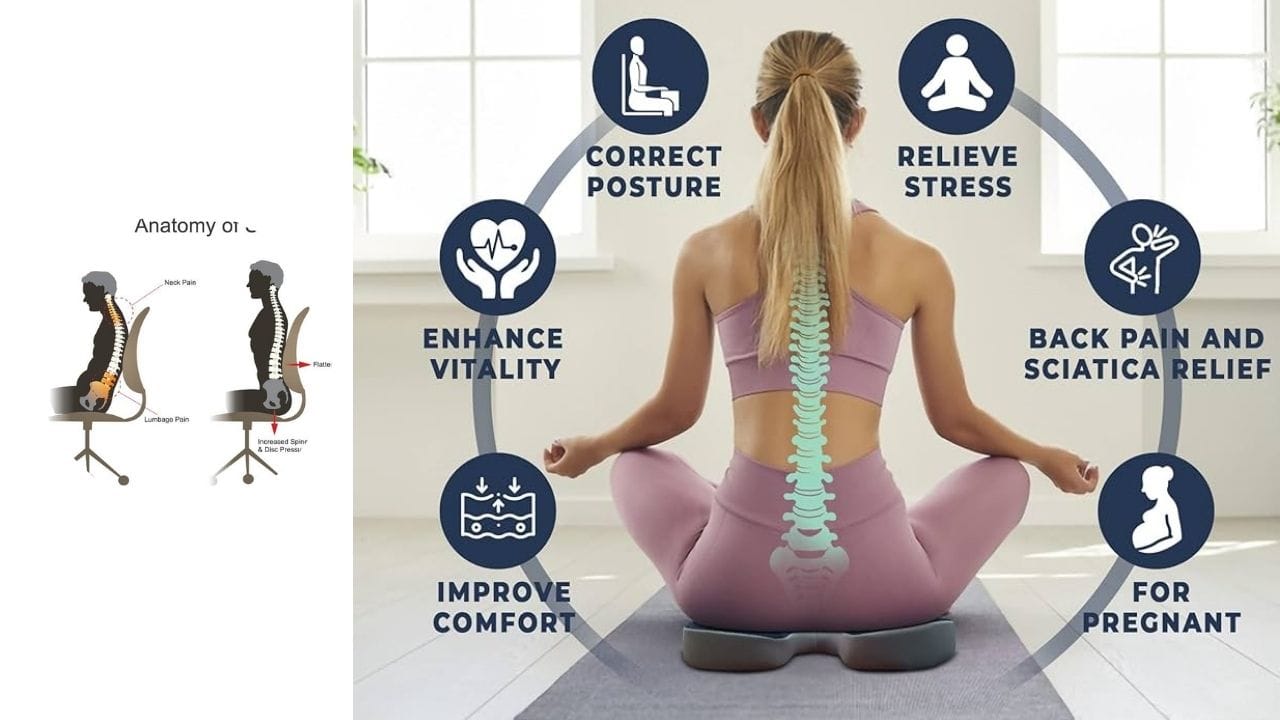Coccyx Pain When Pregnant - Tips & Tricks
Utilizing supportive cushions, practicing proper posture, and engaging in gentle exercises can offer relief and enhance comfort for expectant mothers experiencing coccyx pain.

Pregnancy is a time of significant change for a woman's body, and with these changes can come a variety of discomforts, one of which is coccyx pain. The coccyx, or tailbone, is the small bone at the base of your spine and can become a source of pain when expecting. This article aims to provide comprehensive information on coccyx pain during pregnancy, offering insights and advice to help manage this condition.
Key Takeaways
- Coccyx pain, also known as tailbone pain, is a common discomfort during pregnancy.
- Hormonal changes, weight gain, and the position of the baby can cause pain.
- There are several ways to manage coccyx pain, including exercises, proper seating, and medical treatments.
What is Coccyx Pain?
Coccyx pain, often referred to as tailbone pain, is a condition that can occur in anyone but is particularly prevalent among pregnant women. The coccyx is a small, triangular bone at the bottom of the spine that can become painful due to various factors during pregnancy.

Understanding what coccyx pain is and why it happens is the first step in managing this discomfort. Pregnancy hormones, weight gain, and the position of the baby can all cause coccyx pain.
Causes of Coccyx Pain in Pregnancy
During pregnancy, the body undergoes numerous changes that can lead to coccyx pain. Hormonal shifts cause ligaments to relax, potentially leading to instability and pain in the coccyx area. Additionally, as the uterus expands, it can pressure the tailbone, and the added weight gain can also contribute to discomfort.
The Role of Posture in Coccyx Pain
Maintaining good posture is crucial for preventing and managing coccyx pain. Slouching or sitting for extended periods can exacerbate tailbone discomfort.

Pregnant women should be mindful of their posture, especially when sitting, to alleviate pressure on the coccyx.
The Impact of Weight Gain
Weight gain is a natural part of pregnancy, but it can also put additional stress on the spine and coccyx. As the body adjusts to the extra weight, the risk of experiencing coccyx pain increases.
Managing weight gain within healthy limits can help reduce the likelihood of tailbone pain. In the U.S. in 2018, the average weight gain among pregnant women was 25.
Hormonal Changes and Coccyx Pain
Hormones such as relaxin increase during pregnancy to prepare the body for childbirth. These hormones can loosen ligaments, including those around the coccyx, which can lead to instability and pain.
Understanding the hormonal aspect of coccyx pain can help expectant mothers anticipate and manage this issue.
The Baby's Position and Tailbone Discomfort
As the baby grows and moves, its position can directly affect the mother's comfort. In some cases, the baby's position can put pressure on the coccyx, leading to pain. Monitoring the baby's position with the help of a healthcare provider can be beneficial in managing coccyx pain.
Exercises to Alleviate Coccyx Pain
Exercise can be an effective way to strengthen the muscles around the coccyx and alleviate pain. Pelvic floor exercises, gentle stretching, and prenatal yoga are excellent options for pregnant women experiencing tailbone discomfort.
The Importance of Proper Seating
Choosing the right seating can make a significant difference in managing coccyx pain. Ergonomic chairs, cushions designed for coccyx pain, and avoiding sitting for long periods can help reduce discomfort.
When to Consult a Doctor
If coccyx pain becomes severe or persistent, it's important to consult a healthcare provider. They can assess the situation and recommend appropriate treatments, including physical therapy or other interventions.
Medical Treatments for Coccyx Pain
In some cases, medical treatments may be necessary to manage coccyx pain. These can include medications that are safe during pregnancy or referrals to specialists such as chiropractors or physiotherapists.
The Role of Heat and Cold Therapy
Applying heat or cold to the affected area can provide temporary relief from coccyx pain. Heat can relax muscles, while cold can reduce inflammation. It's important to use these therapies safely and as recommended during pregnancy.
Supportive Gear for Coccyx Pain
Supportive gear such as maternity belts or cushions can provide additional support and alleviate pressure on the coccyx. These items can be beneficial during the later stages of pregnancy when coccyx pain may be more pronounced.
The Benefits of Water Therapy
Water therapy, or hydrotherapy, can be a gentle and effective way to manage coccyx pain. The buoyancy of water can relieve pressure on the tailbone and allow for pain-free movement and exercise.
Dietary Considerations for Coccyx Pain
A balanced diet can contribute to overall spine health and may help manage coccyx pain. Ensuring adequate intake of calcium and vitamin D is important for bone health while maintaining a healthy weight can reduce stress on the coccyx.
The Connection Between Stress and Coccyx Pain
Stress can exacerbate coccyx pain by causing muscle tension. Finding ways to manage stress, such as meditation or prenatal massage, can help reduce tailbone discomfort.
The Importance of Rest and Sleep
Getting enough rest and finding comfortable sleeping positions is essential for managing coccyx pain. Using pregnancy pillows and avoiding sleeping on the back can help alleviate pressure on the tailbone.
Long-Term Outlook for Coccyx Pain
For most women, coccyx pain resolves after giving birth as the body recovers and hormones stabilize. However, understanding the long-term outlook and potential for recovery is important for managing expectations and recovery.
Summary
Coccyx pain during pregnancy is a common issue that arises from hormonal changes, weight gain, and the baby's position. Maintaining good posture, engaging in exercises, using proper seating, and consulting with a healthcare provider when necessary are all important strategies for managing this discomfort. With the right approach, expectant mothers can find relief and enjoy a more comfortable pregnancy.
FAQs
Q: Is coccyx pain a normal part of pregnancy?
A: Yes, coccyx pain, also known as tailbone pain, can be a normal part of pregnancy for many women. As the body undergoes significant changes to accommodate the growing baby, increased pressure on the pelvic area and hormonal shifts can contribute to discomfort in the coccyx region.
The expanding uterus and the body's production of the hormone relaxin, which softens ligaments in preparation for childbirth, can affect the stability of the tailbone and surrounding structures. While coccyx pain is common, its severity varies among individuals.
Thankfully, there are several strategies to alleviate this discomfort, including proper posture, using cushions for support while sitting, and engaging in gentle exercises or stretches tailored to pregnancy. However, expectant mothers must consult with their healthcare provider to ensure a personalized approach to managing coccyx pain during pregnancy.
Q: What can I do at home to alleviate coccyx pain?
A: To alleviate coccyx pain at home, consider implementing a multifaceted approach. Begin by creating a comfortable seating environment, utilizing a cushion or pillow with a coccyx cutout to relieve pressure on the tailbone.
Engage in gentle stretching exercises, such as pelvic tilts and knee-to-chest stretches, to improve flexibility and reduce tension in the pelvic area. Applying heat or cold packs to the affected area can help alleviate inflammation and provide temporary relief.
Maintain good posture while sitting and standing to prevent additional strain on the coccyx. Incorporate activities that promote overall well-being, such as walking or swimming, as these can enhance blood circulation and contribute to pain management. If the pain persists or worsens, it's crucial to consult with a healthcare professional for personalized advice and potential further intervention.
Q: When should I see a doctor for coccyx pain during pregnancy?
A: If you're experiencing coccyx pain during pregnancy, it's advisable to consult with a doctor when the discomfort becomes persistent or significantly affects your daily activities.
While mild discomfort is common due to hormonal changes and the growing uterus, persistent or severe pain may be indicative of an underlying issue such as a misaligned coccyx or ligament strain.
Additionally, consulting a healthcare professional becomes crucial if the pain is accompanied by other concerning symptoms like numbness, tingling, or difficulty walking.
Seeking timely medical advice ensures a thorough evaluation, proper diagnosis, and the implementation of suitable interventions, providing relief and maintaining your overall well-being throughout the pregnancy.
